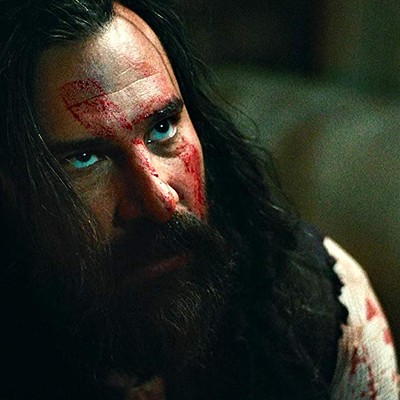In three of his last four films (Godzilla, Independence Day and now The Day After Tomorrow), he pretty much blows up the whole country. That alone wouldn't show his hatred, of course, but in the remaining film, The Patriot, he undoes the founding myth of America by making the War for Independence into nothing but a revenge fantasy, and further insults us getting fellow foreigner Mel Gibson to play a revolutionary soldier as an apolitical, vengeance-driven dog thief. OK, big deal: If he wants to use our national art form, the action film, against us, that's OK, because, to paraphrase a BBC sports report from 1966, over the course of the last century, we beat the Germans twice at their national art form.
The Day After Tomorrow, strangely, is not a sequel to the 1983 TV movie The Day After, nor to the Robert Duvall tear-jerker Tomorrow. Rather, it's a science-fiction thriller about a global storm that creates a new ice age in seven days.
While, science-wise, this seems pretty unlikely, fiction-wise, it's a decent idea for a film. What would be strange, though, would be if Emmerich actually made a good movie, because, after spending exactly $1 zillion, he has, up to this point in his career, made nothing but what the Bavarians call "scheisse."
So it's kind of stunning that Day After Tomorrow doesn't blow like a breaching beluga. Instead, it only kind of sucks. In fact, only a part of it sucks: the part with the characters and the drama. The other part, with the special effects and the weather, is awesome.
Basically, Emmerich makes the same mistake that every other filmmaker has made in virtually every other film: He assumes we need characters in order to enjoy the movie. So instead of just doing a film about the weather, he has to focus on a handful of people and their failed familial relationships and how those relationships are redeemed and blah blah blah who cares.
When the movie isn't dealing with issues better left to Dr. Phil, it's tremendously entertaining. In fact, the special effects here are so special and effective that they do something that special effects almost never do: they carry the film.
So why include people and their pathetic tales of heartache? Emmerich actually cuts from a really cool scene of a Russian tanker floating down a flooded city street to a scene where a little boy with cancer feels sad because his mommy isn't there. Dude, I do not want to see heartwarming when I'm trying to watch planet-wide destruction.
When he sticks with big effects and the overarching story of doom, though, his film really works. These aren't your standard stuff-blowing-up effects. These are creative, original and inventive effects you've never seen before.
In one of the most visually stunning moments in this visually stunning film, the skies above New York fill with birds fleeing an approaching storm. It's a gorgeous shot that borders on breathtaking. There's also some amazing footage of giant tornadoes destroying Los Angeles, a wall of water shooting down Fifth Avenue, a fortress-like cloud engulfing England, and so many more weather scenes that you can barely count them.
There's also some surprisingly funny political commentary. As Americans flee the cold, they're stopped at the Mexican border and denied admittance. Many illegally cross the Rio Grande while the U.S. president tries to negotiate a better immigration policy from the Mexican president.
And there are some hilarious scenes in the White House wherein the vice president, played by Dick Cheney look-alike Kenneth Welsh, tells an indecisive president what to do.
In the course of the film's two hours, there is, mercifully, only about 30 minutes of the obligatory Human Story. Dennis Quaid, in what might be the worst performance by anyone who's ever done Meg Ryan, plays a scientist who thinks that a new ice age is coming. Of course, by dedicating himself to science, he's neglected his son (Jake Gyllenhaal), his wife and his acting lessons.
So when the big one hits, and his son is trapped in a frozen New York, Quaid sets off on foot to rescue him. That you could walk several hundred miles through the deadliest storm in history is not only implausible; it's also boring. What kind of psychedelic bratwurst was Emmerich eating when he thought, "I know: There's too much cool footage of swirling ice and climatic awesomeness. Let's cut to a long shot of a guy walking on snow shoes!"
In the end, though, the painfully heartfelt dialogue and high school-play acting only partly detracts from this otherwise diverting film. While Emmerich gets his lederhosen in a bunch about what he thinks is wrong with America, he nonetheless shows something that was not apparent in any of his earlier works: artistry. It's not the artistry of subtle storytelling and sympathetic characterization, nor that of thoughtful meditations on humanity, but it is that particularly German artistry of the grand scene and spectacular tableau, which is to say that Emmerich has made a film that might best have been called Triumph of the Weather.












